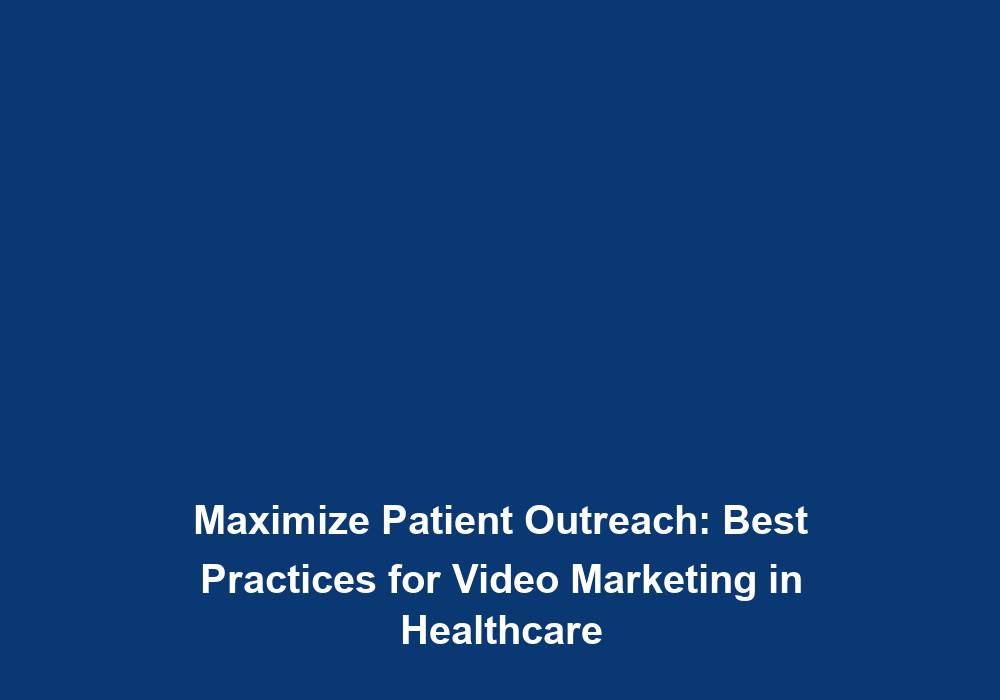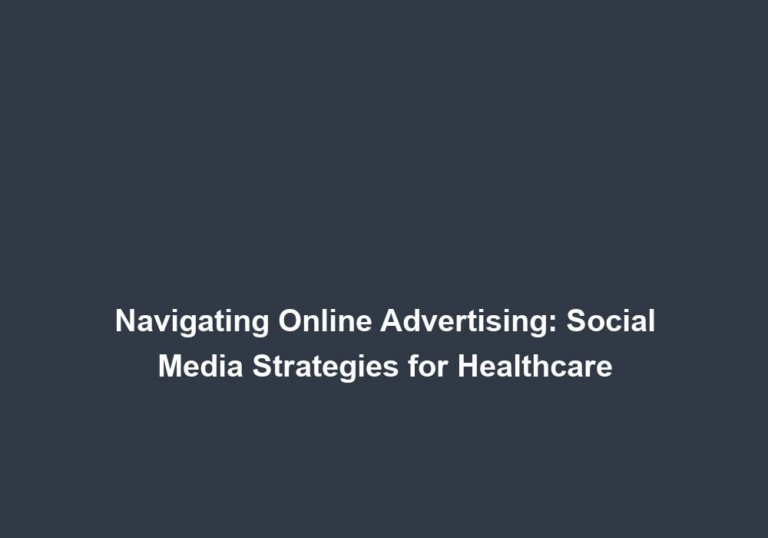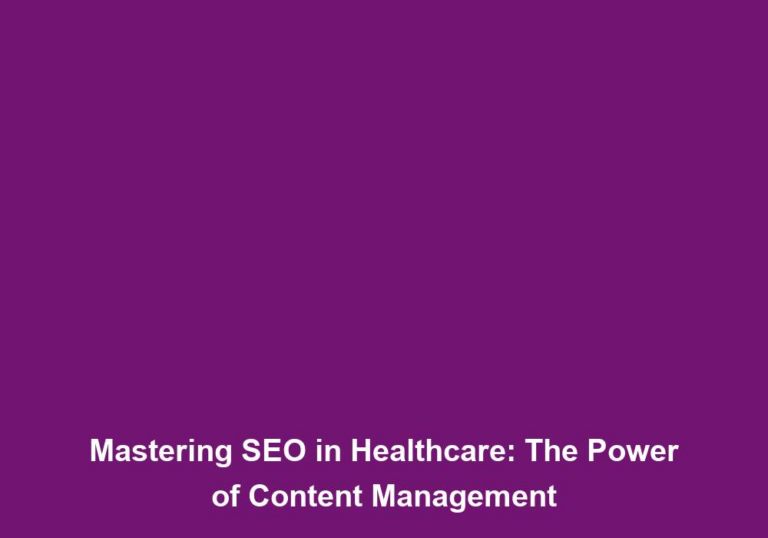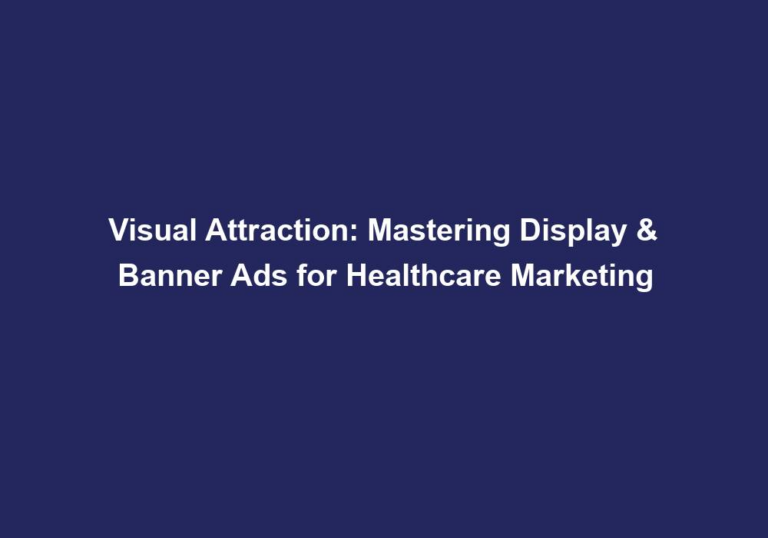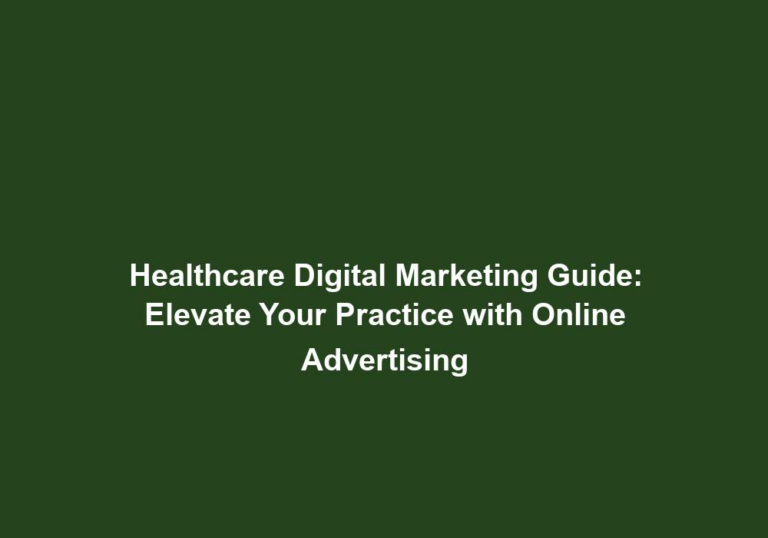Maximize Patient Outreach: Best Practices for Video Marketing in Healthcare
In the digital age, video marketing has emerged as a powerful tool for healthcare providers to connect with patients, share valuable information, and enhance overall patient outreach. With the increasing popularity of online platforms and the rise of video content consumption, it is crucial for healthcare organizations to leverage video marketing effectively. In this article, we will explore the best practices for video marketing in healthcare that can maximize patient outreach and engagement.
Why Video Marketing Matters in Healthcare
Video marketing has become an essential component of successful marketing strategies in various industries, and healthcare is no exception. Here are some key reasons why video marketing matters in the healthcare sector:
- Enhanced Patient Engagement: Videos have the ability to captivate and engage viewers more effectively than traditional text-based content. By incorporating videos into your marketing efforts, you can create a more immersive and memorable experience for patients.
- Videos can use visual and auditory elements to create a more engaging experience for patients, allowing them to better connect with the information being presented.
- By incorporating storytelling techniques, videos can evoke emotions and create a deeper connection with patients, leading to increased engagement and interest in the healthcare organization.
- Improved Information Retention: Research suggests that people are more likely to remember information presented in video format compared to other mediums. This can be particularly valuable in healthcare, where patient education plays a critical role.
- Videos can use visual aids, such as diagrams and animations, to simplify complex medical concepts and make them easier for patients to understand and remember.
- By providing information in a visually engaging format, videos can help patients retain important healthcare knowledge, leading to better-informed decisions and improved health outcomes.
- Increased Brand Awareness: Video marketing allows you to showcase your healthcare organization’s unique offerings, services, and expertise to a wider audience. It helps to build brand awareness and establish your organization as a trusted resource in the industry.
- By creating videos that highlight your organization’s values, mission, and expertise, you can differentiate yourself from competitors and build a strong brand identity.
- Sharing informative and engaging videos on various platforms can attract new patients and establish your organization as a go-to source for reliable healthcare information.
- Better Communication of Complex Topics: Healthcare often involves complex concepts and medical jargon. Videos can simplify these topics, making them more accessible and understandable for patients. This promotes effective communication between healthcare providers and their patients.
- Videos can break down complex medical information into digestible, easy-to-understand segments, ensuring that patients can grasp important details without feeling overwhelmed.
- By using clear and concise language in videos, healthcare providers can bridge the communication gap and ensure that patients have a thorough understanding of their health conditions and treatment options.
Best Practices for Video Marketing in Healthcare
To maximize patient outreach and create impactful video content, it is essential to follow these best practices:
1. Understand Your Target Audience
Before creating any video content, it is crucial to understand your target audience. Consider their demographics, preferences, and specific healthcare needs. This understanding will help you tailor your videos to resonate with your intended audience, resulting in higher engagement and better patient outreach.
- Conduct thorough market research to gain insights into your target audience’s age, gender, location, and health concerns. This information will enable you to create videos that address their specific needs and interests.
- Use surveys, focus groups, and social media analytics to gather feedback from your target audience. This will help you understand their preferences and expectations when it comes to video content, allowing you to create more relevant and engaging videos.
2. Choose Relevant and Valuable Topics
Selecting the right topics for your healthcare videos is pivotal. Focus on addressing common patient concerns, providing educational content, and offering valuable insights related to your specialization. By providing relevant and useful information, you position your organization as a trusted authority in the field.
- Identify the most frequently asked questions or concerns among your target audience. Create videos that directly address these topics, offering practical solutions and expert advice.
- Stay up to date with the latest trends and advancements in your field. Create videos that discuss emerging treatments, breakthrough research, and innovative healthcare technologies, positioning your organization as a thought leader in the industry.
3. Keep Videos Concise and Engaging
In the fast-paced online world, attention spans are limited. To ensure maximum engagement, keep your videos concise and to the point. Aim for a duration of no more than a few minutes, delivering the key message effectively. Consider incorporating engaging visuals, storytelling techniques, and a conversational tone to captivate your audience.
- Use attention-grabbing visuals, such as animations, infographics, and real-life examples, to enhance the visual appeal of your videos and maintain viewer interest.
- Incorporate storytelling elements, such as personal anecdotes or patient success stories, to create an emotional connection with your audience and keep them engaged throughout the video.
- Adopt a conversational tone in your videos to make viewers feel like they are having a one-on-one conversation with a trusted healthcare professional.
4. Optimize Video Titles and Descriptions
To enhance the discoverability of your video content, optimize the titles and descriptions. Use relevant keywords and phrases that align with your target audience’s search queries. Additionally, include a brief summary or teaser that entices viewers to click and watch the video.
- Conduct keyword research to identify popular search terms related to your video topic. Incorporate these keywords naturally into your video titles and descriptions to improve their visibility in search engine results.
- Use enticing and compelling language in your video titles and descriptions to pique the curiosity of potential viewers. Highlight the key benefits or takeaways they can expect from watching the video.
5. Leverage SEO Techniques
Implementing search engine optimization (SEO) techniques can significantly boost the visibility of your video content. Conduct keyword research to identify popular healthcare-related search terms and incorporate them strategically in your video titles, descriptions, and tags. This will help your videos rank higher in search engine results and attract more organic traffic.
- Use relevant keywords in your video file names, captions, tags, and metadata to optimize your videos for search engines.
- Create a keyword-rich video transcript and include it in the video description or as a separate text file. This allows search engines to index the content of your video and improve its discoverability.
6. Incorporate Captions and Transcripts
Including captions and transcripts in your videos enhances accessibility for all viewers, including those with hearing impairments or language barriers. Captions also improve SEO by providing search engines with text-based content to index, increasing the chances of your video being discovered.
- Use closed captions or subtitles to make your videos accessible to viewers who are deaf or hard of hearing. This ensures that they can fully understand the content and engage with your videos.
- Include a transcript of your video in the video description or as a separate text file. This not only helps viewers who prefer reading over watching videos but also improves the overall SEO of your video.
7. Share Videos on Multiple Platforms
To maximize patient outreach, distribute your videos across multiple platforms. Besides hosting them on your website or YouTube channel, consider sharing them on social media platforms, healthcare forums, and relevant online communities. This expands your reach and makes it easier for patients to discover and engage with your content.
- Create a comprehensive social media marketing strategy to promote your videos on platforms like Facebook, Twitter, Instagram, and LinkedIn. Tailor your content to fit the specific requirements and demographics of each platform.
- Participate in healthcare-related forums, groups, and communities, and share your videos as valuable resources. Engage in discussions and provide further insights or clarifications related to your video content to establish yourself as an industry expert.
8. Encourage Social Sharing and Comments
Active engagement and interaction are crucial for successful video marketing. Encourage viewers to share your videos on social media platforms, leave comments, and ask questions. Respond promptly and thoughtfully to foster a sense of community and build trust with your audience.
- Include social sharing buttons within your video player or video description to make it easy for viewers to share your videos with their networks.
- Prompt viewers to leave comments or ask questions at the end of your videos. Respond to these comments in a timely manner, providing additional insights or clarifications to encourage further engagement.
9. Monitor and Analyze Video Performance
Regularly monitor and analyze the performance of your video content. Utilize analytics tools provided by platforms like YouTube or social media to gain insights into viewer behavior, engagement metrics, and overall performance. This data will help you identify areas for improvement and refine your video marketing strategy.
- Track key metrics such as views, watch time, engagement rate, and click-through rate to measure the success of your videos. Identify patterns and trends to understand what types of video content resonate most with your audience.
- Use A/B testing to experiment with different video formats, lengths, or topics. Analyze the performance of each variation to determine which ones generate the most engagement and achieve your desired goals.
10. Stay Compliant with Privacy and Security Regulations
In the healthcare sector, patient privacy and data security are of utmost importance. Ensure that your video marketing practices are compliant with relevant laws and regulations, such as HIPAA (Health Insurance Portability and Accountability Act) in the United States. Safeguard patient information and obtain necessary consents before featuring individuals in your videos.
- Familiarize yourself with the privacy and security regulations applicable to your region. Develop protocols and procedures to ensure that patient information is handled securely throughout the video production and distribution process.
- Obtain written consent from patients or individuals featured in your videos, clearly explaining how their information will be used and shared. Maintain proper documentation to demonstrate compliance with privacy regulations.
By following these best practices, healthcare organizations can effectively leverage video marketing to maximize patient outreach, engage audiences, and establish a strong online presence. Embrace the power of videos to connect with patients, educate and inform them, and ultimately improve overall healthcare experiences.

